| |
"...has all the fun and gaiety of a burning orphanage." |
| |
Variety's first review of Harold And Maude |
| |
"There's no story line or anything like that running through my pictures, but I do try to do films that deal with human relations, with people relating to one another." |
|
Director, Hal Ashby |
In 2014, that simple declaration seems almost subversive. Isn't that a shame? Still, to those in the know at that time, despite his embracing of his inner (and outer) hippy and his latter-career slide into drug abuse, Hal Ashby was regarded as one of the best directors of the 70s. The content of his oeuvre, though collectively not many in number, is dotted with all manner of superior movies. The Last Detail is an unalloyed, crass and profane delight with Jack Nicholson at the height of his potency. Ashby's one of those figures that lurk in the shadows of fulsome appreciation. Drill down and you can discover how good this guy actually was and curiously his directorial role model was William Wyler, an old Hollywood stalwart famous for Ben Hur and The Best Years Of Our Lives. Ashby has a place in my heart not just for the movies he directed but for those he cut (he got an Oscar for editing In The Heat Of The Night). He credited his editor's craft as being the perfect apprenticeship for direction. If I could agree more, I really would strain something. As an editor you can not only see the blueprint of intention but the reality of the bricks and wood too and how the actuality of a movie veers rebelliously and artistically away from the written word. One of my very own clichés is that a film director is just a film editor with people skills. With some practical caveats, it's almost the same job. What is editing but direction and vice versa?
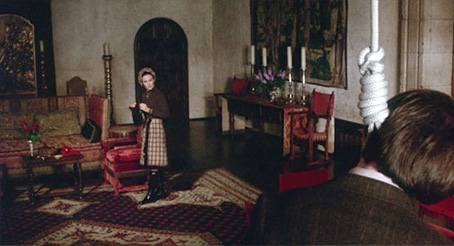
Ashby's second film is a curiosity well off the beaten track and then some and it's all the better for its singular location. Harold And Maude heralded the extraordinary growth and maturity into which 70s Hollywood would bloom. The irony of the script being originated while writer Colin Higgins was still in higher education is not lost on me. The story is an unconventional one and starts with a reverent single shot moving carefully to keep focus and emphasis on the formal actions of a young man, his face barely glimpsed. He puts on a record... (Don't Be Shy by Cat Stevens, more on his contribution later). Despite the levity of the folk song, the visual tone is almost religious. Candles are lit and then just as the credits come to an end and the last beat of the music stops, (and the action is deliciously and exquisitely timed) the young man steps off a stool, his foot striking the wood in time with the song's last note as he hangs himself. Say 'Hullo!' to Harold. His legs swing as Hal Ashby's director credit comes up. Now, it is impossible to talk about Harold's behaviour and keep his actions a secret but the less you know about his activities, the more fun is to be had. Now, how are we feeling? Is the film going to be a flashback? After all, we saw Harold put on a nametag so we know this is the 'Harold' of the title. What breaks this spell is the introduction of one of the best comic performances I've seen in a comedy, black as this one most definitely is. Now Bud Cort (Harold) and Ruth Gordon (Maude) deservedly take the principal acting honours but I would be letting my own critical side down if I didn't hold Vivian Pickles up as one of the truly unsung greats in this little, beloved movie. Ashby cast Pickles after seeing her in Ken Russell's Isadora Duncan, the Biggest Dancer in the World. She plays Harold's mother, Mrs. Chasen and both her and the direction in the continuance of the opening 'hanging scene' are impeccably judged and both are priceless. I'll say no more.
Harold has a few psychological problems that manifest themselves in a number of increasingly elaborate, theatrical 'suicides'. This behaviour is not seen as surprising given the mother he has. Obscenely wealthy and used to solving any problem with a plethora of dollar, she's at her wits end with her twenty-year old son who is spoiled beyond rotten and spectacularly unappreciative (he's given an E-Type jaguar at one point to cheer him up a bit, a luxury car which, acetylene torch in hand, Harold gleefully welds into a hearse). Harold is closed off to the world and finds his mother's control absolute and stifling. His very existence is a quiet rebellion and he ratchets up the nuisance factor every time there's a well-meaning visitor. His mother even tries to marry him off as if this would solve anything and uses the services of a select dating agency that – and I quote – "...screen out the fat and ugly." Oh, so that's OK then. For some reason this reminded me of a friend's mother's statement to her son when he started dating girls. "And if you bring home some busty girl, I'll know that you have only one thing on your mind..." The singular unfairness of that struck me hard. So where do the 'busty' girls go for their fun? And then the answer to that struck me even harder.
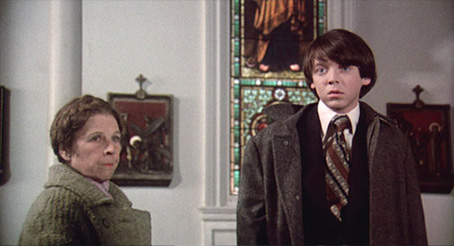
Of course, Harold's in psychiatric analysis and getting nowhere and all the entertainment or diversion he requires is to be present at strangers' funerals. It's at one of of these that he meets Maude after the best-timed sneeze on film. Maude is seventy-nine years old and prone to lawless behaviour, acts which underline and emphasize her lust for life. She is the antithesis of the controlled and controlling Mrs. Chasen and at first Harold is bemused by her forwardness but soon regards her as a friend and then more... This is a movie about being truly alive, a sprocketed 'carpe diem', the unlocking of passion and promoting emotion to inspire and entice the fogbound into the light. It's also very sweet. We've all been Harold at some point in our lives (a big assumption but mostly true I think). We've all stared at the world through eyes that only see how ungainly we are, how unsure of ourselves, how hesitant we are to grasp life by the lapels. We are all misunderstood to some degree and the lucky ones find catalysts (human or otherwise) that push us out of our own cages into accepting and being comfortable with who we are. It's a big and somewhat sentimental theme but the vivacity of the fiery Ruth Gordon and the thawing of Bud Cort is a winning combination that acknowledges the touchy-feely but balances it with black humour and a refusal to judge its characters with anything but equanimity.
I've read a great deal about the 'reason' for Maude's abundant vivacity that is never explicitly stated. From a faded tattoo we deduce that Maude has spent time in a concentration camp (there's a very brief 36 frame close up insert of the numbers on her wrist in the sunset scene, blink and you will miss it). She acknowledges Harold's unasked question with a story about the French Officer, Alfred Dreyfus wrongly imprisoned for treason and how he saw 'glorious' birds from his cell. Later he realises they were 'only' seagulls. Maude is communicating something profound but obliquely. There are other clues to Maude's past dotted about the film. She lives in a refurnished old train carriage. Might this be a dark metaphor, living in a space in which so many were transported to be murdered in the most unspeakable atrocity human beings have ever perpetrated? She also carries an umbrella for protection implying her politics may have got her into trouble more than once.
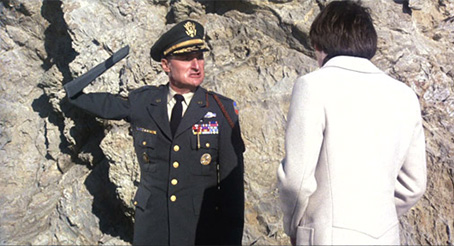
The supporting characters are all victims of Harold's morbid scorn or Maude's penchant for doing the right thing even if that means boosting a car to save a forlorn tree. The only character not phased by Harold's theatrics is an actress who accepts his bloody seppuku as a performance for her benefit only. It was a delight to see Captain Dallas himself, Tom Skerrit being given the literal runaround by a near octogenarian. His credit ('M. Borman') points to a longstanding friendship between him and Ashby. "Possession of a stolen shovel," he hisses in triumph before Maude nicks his motorcycle. The one armed Uncle Victor (Charles Tyner) does comic wonders with his absent saluting arm trying to deliver the glories of military life to a boy with only a wonder in morbidity. Harold and Maude's reduction of the crass, racist idiot is a gleeful dance, shrunken head a-swaying.
Speaking of dancing, on the both occasions of Harold and Maude doing just that, we hear the ever-dependable Blue Danube by Johann Strauss II (or to give it its original name, 'An der schönen blauen Donau'). It takes some balls to reclaim the music as a waltz after 2001 had crystallised it as 'space music' only two years earlier. I guess decades help in the crystallisation process. There are lovely details in Harold's chat with his uncle at the old soldiers retirement home. Keep your eye on the background to the leisurely walk. Notice Harold's gleeful skip after being told to call his Uncle, 'Sir'. None of these small but potent pleasures are overstated. They are just there to be appreciated if you're paying attention and it's likely Harold And Maude will repay multiple viewings because it's pretty dense both physically and metaphorically. In my two recent viewings, I noticed all sorts of detail that eluded me way back in my teens but still the sunset shot from behind the pair as Harold pulls Maude in close is one of the most romantic expressions of unadulterated love I've ever seen on film. It brings tears to the eyes by the power of its purity. All this, with a Cat Stevens accompaniment "If you want to sing out, sing out..." too. Just beautiful.

The movie is full of moments and diversions within frame, aspects that you do not pick up on at a first, second or even a third viewing. When we see Maude for the first time eating an apple, (when we can make out it is actually Maude) there is a gravestone in the foreground with the prominent name of 'Donovan' on it. Now I may be piling unintended meaning on this (it could have been a complete coincidence) but Cat Stevens' main competitor at the height of his fame was the so named Scottish folk singer. There was a story this week about an American student in Germany who got stuck in a stone vagina (got to hand it to the world for coming up with this stuff). It perfectly mirrors Cort's improvisations regarding Maude's own wooden one. Stop tittering at the back. She has a giant carving in her rail carriage apartment. But my favourite Cort improv (how he stays in character I'll never know) comes after his first computer date runs out of the house screaming. Cort stands with his perplexed mother and very slowly turns to the camera in effect breaking the fourth wall and gives us all a delicious, conspiratorial smile. As soon as he slowly turns back, he returns to the movie and responds to his mother's disapproval with such a genuine reaction, you bark out a laugh at first and then slide effortlessly into pity. Masterful. Ashby loved it and left it in. I can think of only two instances inside a normally 'normal' movie (not Annie Hall where it's woven into the style of the piece) when an actor has done that. Richard Dreyfuss suddenly looks right into the lens while driving the Orca in Jaws and there's that delicious wink from Blanche (Barbara Harris) in Hitchcock's swan song, Family Plot.
Singer/songwriter Cat Stevens was heavily involved creatively with the film (he's even in it playing a mourner at the third funeral). When his other commitments didn't allow him to finish the score – he'd already written two bespoke songs – Ashby caught up with him and negotiated the use of pre-written songs that the film could be edited to. Stevens agreed. Now I'm not a big fan of Cat Stevens (however, his songs in the film are delightful and form a structurally sound signature. I can't think of Harold, Maude or Cat Stevens individually without the other two popping up unbidden). I am aware of his great success in the 70s and I'd say that his association with this movie means he has a place in film history. What interests me about Cat Stevens is the fact he isn't Cat Stevens any more. He converted to Islam in 1977 and took the name Yusuf Islam a year later. If you'd been paying attention, analysing his lyrics, you'd see that he was basically asking for conversion and he fell in love with the call to prayer while in Morocco. There is a frankly odd story about him praying to God to save him from drowning and that if God did this, he would serve Him for the rest of his life. I find it absolutely fascinating that a man can find a spiritual home inside a belief system that originated in the middle ages and continues to support some very antiquated and frankly appalling sexual politics. Being conditioned from childhood I can understand. Converting as a grown man, I do not get. I don't know why I'm surprised at things human beings are capable of any more.
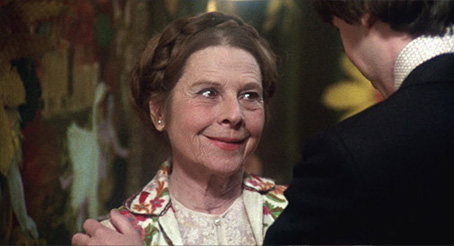
Finally, a movie directed by an editor should contain at least one of two things... Near invisible craft and transitions like trompe l'oeil, the forwarding of narrative that if you really are paying attention should make you go "Uh, how did we get here?" when we just accept without question the editorial sleight of hand. Once Maude relinquishes control of Harold's hearse, Harold crosses over to the driver's side in a wide shot and pulls open the door. The next cut – action match perfect – takes us to his opening the car door for Maude outside her renovated train carriage of a house. It's the sort of cut that makes people like me go "Aaah... I love you, Hal Ashby." Let's not diminish the actual editors' contributions (take a bow William A. Sawyer and Edward Warschilka) but a transition like that is usually in the director's head from day one. I must amend that slightly after hearing on the commentary that the rough cut was three hours long and it was shorn by half of its original length. Perhaps that cut was suggested by the severe trim down and I'm dong the two editors a disservice. It doesn't really matter who's responsible. It just matters that it's there and that it works so beautifully. There's another extraordinary trompe l'oeil edit as Harold somersaults on the grass away from Maude and an action cut takes us to Harold moving back towards Maude. It's like he span one hundred and eighty degrees in the twenty fourth of a second! And you just buy it. The cutting throughout is razor sharp and some edits are used as shock tactics. The cut after Harold's shocked and despairing "WHAT?" after hearing news he's reluctant to process, is a masterstroke in how to streamline your narrative. It's also a great example of a terrific sound edit, the outgoing and incoming seem to be the same sound for a split second. Intercutting the final two scenes was a calculated risk. If you stop and really think about what you're watching, one scene's actual presence gives a very clear indication of the ending of the scene it's intercut with. Ashby's on his own tightrope here but it works wonderfully with a very emotional pay off.
I am so happy to report that this beloved forty-three year old movie has not lost a single ounce of its power or humour over the years. Yes, of course, it could never be made today for all sorts of reasons but seeing it again after such a long period, I was a little afraid my memory might have been investing the film with more than what's there. But I'm happy to report Harold And Maude has had the same effect on me today as it had all those years ago. Kudos, Mr. Ashby and company.
Presented in 1.85:1, and not resized to fit 16:9 TVs, the movie looks pretty good. Visually, it is so locked into the 70's film stock aesthetic; it could almost be the epitome of the species. While the blacks are pleasingly dense and there's a perfectly good contrast ratio throughout, it doesn't quite sing the way Blu-rays can. The film grain is evident but again nowhere near the level of intruding on your viewing enjoyment. You're so taken with the characters and the movie's pace that any visual defect or anomaly is not even considered.
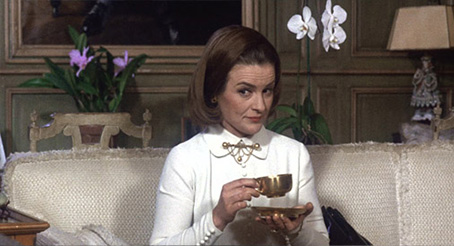
In respect of the PCM audio, you have the choice of the original mono soundtrack or a beefed up stereo one. I'm all for supporting the original versions in all aspects of film preservation but the extra bass and spacial widening tempted me over to the stereo every time.
There are English subtitles for the deaf and hard of hearing.
Video discussion of the film by critic David Cairns (25' 44")
This is a straightforward mid to long shot of David Cairns in an empty Edinburgh auditorium with the camera angle changed twice intercut with selected relevant clips and photos. Cairns' views on the film are lively and enthusiastic. There is an odd audio disparity between the clumsily shoehorned in questions (did the Extra-makers not like the sound of the real interviewer's voice?). Cairns makes some mention of Vivian Pickles' role in the film and asks why cast an English actress and muses whether her style of acting may have sent the movie over the top. I beg to differ. Her performance, like any performance in a movie, can never be attributed solely to the actor. It's a partnership with the director and for my money, Pickles' performance perfectly establishes what Harold is up against as Ashby had planned. With appreciative nods to both Gerald and Ralph respectively, Vivian Pickles Scarfes and Steadmanises the American upper class with great precision. Had she been any more sympathetic, her monstrous disregard for own son would be blunted and playing the role any broader would have turned genuinely black and bleak humour into cartoonish pantomime. I think she and Ashby got Harold's mother unequivocally spot on. My favourite part of Cairn's presentation is the story of what happens when you introduce students to this film. It's happening more and more with me, showing younger people older work and having their conception of cinema enlarged beyond the glut of CG, body horror, and mawkish shite. There are gems to be mined from the past and Harold And Maude shines particularly brightly.
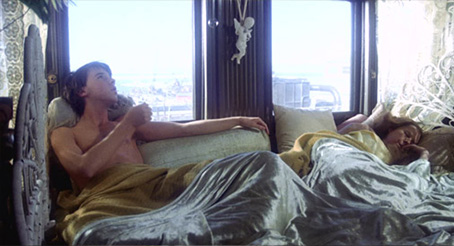
Audio commentary by Hal Ashby biographer Nick Dawson and producer Charles B. Mulvehill
Ported from the Criterion Collection release of 2012, this is a terrific commentary track. On Amazon, this extra also lists the participation of Hal Ashby (a neat trick as he's been dead for thirty-six years). Producer Mulvehill (aka, the hearse seller from the movie) provides the 'witness' account of the making of the film and Dawson fills in with all the relevant background information, the movie's historical context and he's clearly an Ashby expert. It's a shame the pieces are edited together from two discrete sessions. Commentaries, to me, are more fun when there's some interaction between the participants. I may be wrong (it's sound edited very well) but the two never acknowledge each other. This is the primary giveaway. Nonetheless this is a fine and in some places touching commentary with a plethora of wonderful tidbits. Can you imagine Elton John, Richard Dreyfuss or Bob Balaban as Harold? With respect to Cort who is wonderful in the part, I think a young Balaban would have nailed it too. It's very pleasing that none of the two ever describes what's happening on screen. I'm thrilled to find out that Bud Cort improvised a lot of my favourite moments in the movie. Bravo. Imagine a three-hour rough cut! Viewed at that length, producer Mulvehill says that if Maude came out with another pontification, he'd slug her. This candid honesty is so true as filmmakers have to live with their creation to the point of suffering polarised and extreme degrees of loathing and affection. The movie was cut down to an hour and a half without losing a single scene – they were all just cut in half! As Maude says "Isn't it exciting, all around us living things!" while Mulvehill says "Can you imagine three hours of lines like that?" There is a wonderfully personal revelation at almost exactly an hour in which I will not spoil. I'll leave the last word to Mulvehill. He notes at the end of the commentary that so many people have since come up to him and expressed their love for this wonderful film. He said, "Where were you when we released it?"
Booklet featuring archival interviews with director Hal Ashby and writer-producer Colin Higgins, a 1971 profile of star Ruth Gordon, and rare archival imagery – 40 pages.
Again, Ashby's interview underlines several fundamentals about the relationship between the editor and director. My neck is sore from vigorously nodding at each of his statements about the craft. The Higgins interview is eye opening. I never made the connection between Harold And Maude and Silver Streak, another (far more guilty) pleasure from the 70s. It also amuses me that the entire film of Harold And Maude was born from Higgins seeing a movie crane and imagining the first uninterrupted shot being filmed with that particular piece of hardware. The parents of great ideas never look like you think they would. The 1971 Ruth Gordon profile places the actress very squarely in Maude-mode. She comes across as driven and if the word 'feisty' didn't already exist... you fill in the rest. Her career advice is somewhat playful (and I'm paraphrasing here; "get serious at four years old. It's too late once you're five...") but she's great value and Bud Cort crops up at the end too with a few telling comments. A bonus. This is another excellent booklet from MoC with relevant and entertaining information you wouldn't readily find online.
Harold And Maude is a film about the affirmation of life, the acceptance of death as an intrinsic part of living and how attractive anyone can be if their spirit takes flight at the mere idea of being on this planet. You quickly see beyond Maude's wrinkles and into the twinkles in her eyes. What Bud Cort can do with a simple look most actors would struggle to achieve with their whole being. This is a glorious and understated movie with an enormous heart that comes very warmly recommended.
|